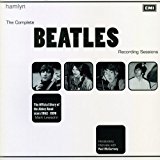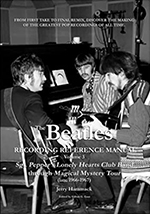Part of
Recording "Sgt. Pepper's Lonely Hearts Club Band"
Nov 24, 1966 - Apr 20, 1967 • Songs recorded during this session appear on Sgt. Pepper's Lonely Hearts Club Band (UK Mono)
- Album Songs recorded during this session officially appear on the Sgt. Pepper's Lonely Hearts Club Band (UK Mono) LP.
- Studio:
- EMI Studios, Studio One, Abbey Road
Timeline
More from year 1967
Some songs from this session appear on:
Spread the love! If you like what you are seeing, share it on social networks and let others know about The Paul McCartney Project.
About
George Harrison’s song “Within You Without You” was recorded on March 15 and 22, 1967, with the assistance of some Indian musicians.
The track was completed this day, from 7 pm to 3 am. It was the last song to be completed for the “Sgt. Pepper’s Lonely Hearts Club Band” album. George Harrison was the only member of The Beatles present at this session. Hours earlier, Paul McCartney had flown to the United States for a ten-day break to visit his girlfriend Jane Asher.
The overdubs added to Take 2 on this day started with the addition of strings. Eight violins and three cellos were conducted by George Martin, who had also written the score. The parts were recorded multiple times onto track three, each wiping the previous attempt, before everyone was satisfied with the result. Each player was paid the standard Musicians’ Union rate of £9, except for Erich Gruenberg, the leader of the ensemble, who was paid £11.
Next, George Harrison recorded his lead vocals, some acoustic guitar, and some sitar, which were all added onto track four of the tape.
Once the recording was complete, the mixing process began. Although the rhythm track was recorded as one piece, it was referred to as having three parts during the recording. For the mixing process, the song was again divided into parts, and Part 1 was mixed separately from Parts 2 and 3. Three attempts at mixing Take 2 Part 1 were made and labeled Remix Mono 1 to 3. Two attempts at mixing Take 2 Parts 2 and 3 were then created and labeled Remix Mono 4 and 5.
The mixing process of “Within You Without You” continued the following day.
Again, George’s contribution, ‘Within You Without You’, was, with all deference to George, a rather dreary song, heavily influenced by his obsession with Indian music at that time. I worked very closely with him on the scoring of it, using a string orchestra, and he brought in some friends from the Indian Music Association to play special instruments. I was introduced to the dilruba, an Indian violin, in playing which a lot of sliding techniques are used. This meant that in scoring for that track I had to make the string players play very much like Indian musicians, bending the notes, and with slurs between one note and the next.
George Martin – From “All You Need Is Ears“, 1979
We were getting near the end of the album now, but there was still a little way left to go. We came back in on Monday 3 April, at 7 p.m. as usual, to finish off. ‘We’, in this case, meant George, myself, and the outside musicians — there were no other Beatles present that night.
It turned out to be a marathon eleven-and-a-half-hour session. We worked our socks off in the big studio, No. 1, until three in the morning, recording the string score I had written to fit the Indian tracks we had already laid down.
I had eight violinists and three cellists, led again by Erich Gruenberg. They were all first-class players in their own right, and they had to be — they found it very difficult indeed to follow and keep up with the elastic swoops and wiry furrows of the dilruba. It was also pretty tedious for them, having to go over and over the same phrase until George was satisfied with it. By now we had only one track left on the tape, so if we did not get everything right on a given take, we just wiped the entire take.
In short, we had to get it right; but we did a lot of takes before George was pleased with the result. George’s meticulousness was worth it, in the end. Gruenberg’s gentlemen-players did the business: we had added another dimension to the song.
When George was finally satisfied with what we had achieved it was about 3a.m., and we all assumed we could go home. The musicians did go, they couldn’t wait to go — it was well past their bedtime. To my astonishment, though, George himself wanted to carry on.
Propping our eyelids up with joss sticks, we moved over to Studio No. 2, across the road, where we spent a further three-and-a-half hours mixing. I eventually got home at seven or so, in time for breakfast. Judy got a cup of tea in bed that morning.
George Martin – From “With A Little Help From My Friends: The Making of Sgt. Pepper“, 1995
George Harrison was the only Beatle in attendance, and the purpose was to bring “Within You Without You” to completion. As was becoming habit, it was a marathon session, running until dawn the next day, but the results were nothing short of magical.
Once again, we were in Studio One, but this time the acoustics worked for the instrumentation being recorded. George Martin was conducting the same top-flight orchestral players that worked on most of the rest of Pepper, but despite their expertise, the musicians took a long time to get it right; I clearly remember the look of deep concentration on their faces as they struggled to master the complex score. It was painstaking, and it certainly was a challenge to the musicians, many of whom seemed to be getting a bit frustrated as the session wore on.
The problem was that we were trying to create a blend of East meets West — conventional orchestral instruments playing over nonconventional Indian instruments. There were no real bar lines in the Eastern music, just a lot of sustained tones, most of which were playing in between the twelve notes used in Western music. That was a really hard session for George Martin — by the end of the night he was absolutely knackered. Thankfully he had the help of George Harrison, who acted as a bridge between the Indian tonalities and rhythms, which he understood quite well, and the Western sensibilities of George Martin and the classical musicians. I was never more impressed with both Georges than I was on that very special, almost spiritual night. Interestingly, from then on, many of George Martin’s orchestrations began exhibiting that same kind of Indian feel, with the string sections doing slight pitch-bending. It actually put a stamp on his arrangements and gave them a unique sound.
After the string overdubs were completed and the musicians had departed, we moved into Studio Two, where George Harrison began tuning his sitar, sitting cross-legged on a throw rug we had put down for him. He onlyhad to overdub three or four licks in the instrumental section, but some of the drop-ins were tricky, and it took hours to do. None of us ever really appreciated how difficult the sitar was to play. Despite the fact that George was quite accomplished, it did always seem to take a lot of time to get his parts recorded whenever he picked the instrument up.
Finally, with the lights down low and candles and incense burning, George tackled the lead vocal, and he did a great job. Mind you, he does sound quite sleepy on it… hardly surprising since he’d been up all night working on the track!
Geoff Emerick – From “Here, There and Everywhere: My Life Recording the Music of The Beatles“, 2006
Last updated on January 13, 2024
Songs recorded
1.
2.
Written by George Harrison
Mixing • Mono mixing - Remix 1 from part 1 of take 2
3.
Written by George Harrison
Mixing • Mono mixing - Remix 2 from part 1 of take 2
4.
Written by George Harrison
Mixing • Mono mixing - Remix 3 from part 1 of take 2
5.
Written by George Harrison
Mixing • Mono mixing - Remix 4 from part 2 and 3 of take 2
6.
Written by George Harrison
Mixing • Mono mixing - Remix 5 from part 2 and 3 of take 2
Staff
Musicians on "Within You Without You"
- George Harrison:
- Lead vocals, Sitar, Acoustic guitar
- Jack Rothstein:
- Violin
- Ralph Elman:
- Violin
- Jack Greene:
- Violin
- Erich Gruenberg:
- Violin
- Alan Loveday:
- Violin
- Julien Gaillard:
- Violin
- Paul Scherman:
- Violin
- David Wolfsthal:
- Violin
- Reginald Kilbey:
- Cello
- Allen Ford:
- Cello
- Peter Beavan:
- Cello
Production staff
Going further
The Complete Beatles Recording Sessions • Mark Lewisohn
The definitive guide for every Beatles recording sessions from 1962 to 1970.
We owe a lot to Mark Lewisohn for the creation of those session pages, but you really have to buy this book to get all the details - the number of takes for each song, who contributed what, a description of the context and how each session went, various photographies... And an introductory interview with Paul McCartney!
The third book of this critically - acclaimed series, nominated for the 2019 Association for Recorded Sound Collections (ARSC) award for Excellence In Historical Recorded Sound, "The Beatles Recording Reference Manual: Volume 3: Sgt. Pepper's Lonely Hearts Club Band through Magical Mystery Tour (late 1966-1967)" captures the band's most innovative era in its entirety. From the first take to the final remix, discover the making of the greatest recordings of all time. Through extensive, fully-documented research, these books fill an important gap left by all other Beatles books published to date and provide a unique view into the recordings of the world's most successful pop music act.
If we like to think, in all modesty, that the Paul McCartney Project is the best online ressource for everything Paul McCartney, The Beatles Bible is for sure the definitive online site focused on the Beatles. There are obviously some overlap in terms of content between the two sites, but also some major differences in terms of approach.




Contribute!
Have you spotted an error on the page? Do you want to suggest new content? Or do you simply want to leave a comment ? Please use the form below!